Heaphy Track Walk
New Zealand
David and Noel Coory
9th to16th Feb 2004
Written by David Coory
Day two
Thursday 12 Feb
Violent storm overnight
A violent storm arises soon after we go to sleep and keeps us awake most of
the night. The wind howls and shrieks around the hut, which is in an
exposed position, high in the ranges. It must have been over 100 kmh in
velocity.
It sounds as if the wind is trying to tear
the roof off, and the rain teems down hour after hour. I find the only way
to get some sleep is to lie sideways on my small pillow and hold my folded
up soft track pants over my other ear to deaden the noise. (Raymond said later
that the noise didn't bother him too much as he is used to it living in
Wellington.)
When morning comes, the rain has stopped and we can see white clouds and
blue sky. The wind is still strong however, and rather cool.
Longest leg of the walk today 27 kms
I don't have any breakfast, as is my custom, but all the
others do.
Today's walk is the longest leg of all, 27 kms. Across high
tussock downs mostly. So we eventually hoist our packs on our backs and set off.
I
feel quite energetic. The strong wind helps to keep us cool. The foam
padding used as cushioning down the inner back of hiking packs tends to make
you hot. Yesterday all the hikers had wet sweat patches on their lower backs and upper
bums.
We start off in bush and cross many attractive streams
over little wooden bridges.
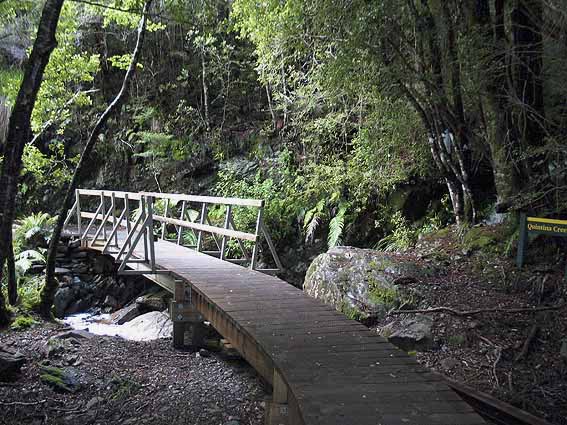
Typical bridging in this part of the track.
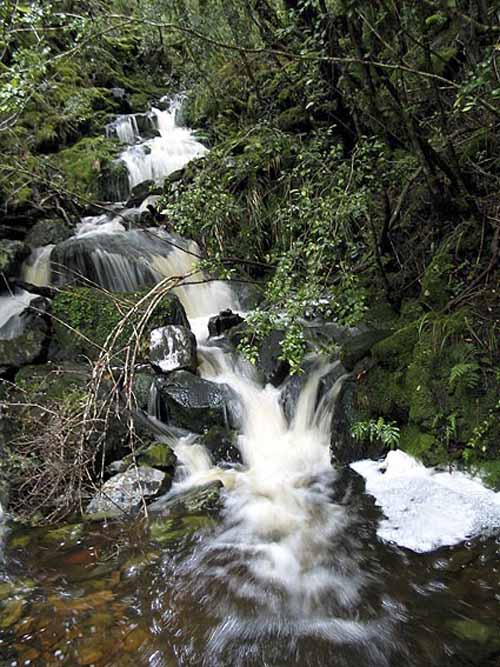
Some of the streams were very attractive.
I slip into the river
The track is still rocky and rough, but not
continually uphill like yesterday.
We crossed several small unbridged streams, stepping on rocks, then we come to a
much larger one than normal. It was quite deep and fast flowing and I would have
expected it to have been bridged.
However, I put it down to the heavy rain we had
overnight. So I start to rock hop across, but due to my heavy pack, which
has an unbalancing effect, and clumsy boots, I slip off a rock and both my
boots go under the knee deep water, soaking them.
Raymond manages to cross OK. He is wearing sports
sneakers as he doesn't have any boots at present.
I later discover that the smaller sole area of light footwear and
their greater flexibility give
you a much better balance when crossing streams with a pack on your back.
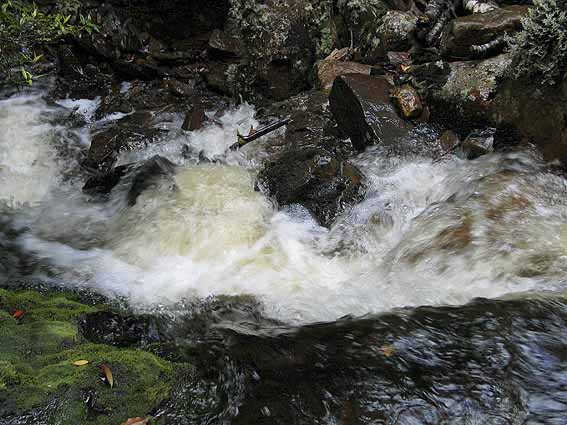
The river I slipped into, wetting my boots.
I have taken my boots off and are standing there in my
bare feet wringing water out of my socks when Raymond gives a sudden laugh.
"Look, there's a bridge." He says. And sure enough, there hidden by
overgrowth is a low bridge over the river. Wet feet for nothing!
I put on my spare pair of dry socks and Raymond finds a
piece of sticking plaster for a cut on my finger that is bleeding from one
of the rocks.
I take a photo of the hidden bridge and we continue on.
But I immediately find that my dry, thick, woollen socks are squelching and
again saturated with water.
Modern boots have soft foam inner linings that soak up a
lot of water. So we have to stop again while I wring out my socks again. Now
both pairs of socks are wet.
It's rather hard taking off boots while trying to stand
on one foot, as there's nowhere dry to sit down.
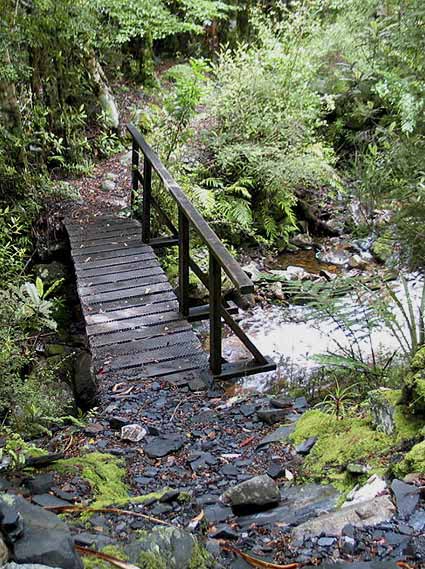
The hidden bridge.
(We crossed further
upstream.)
Edited to here
Picturesque streams and
colourful pool
We carried on. There were many picturesque streams in
this area, all well bridged. Very pleasant walking. Even my damp socks were
comfortable as they kept my feet cool. We also found some pools that were an
unusual orange and green colour. We passed some of the other walkers here.
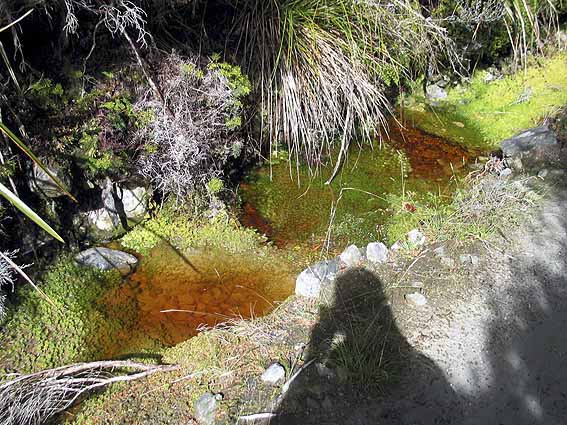
Green and orange pool.
We enter tussock
country
Soon we left the bush of the gullies and came out onto
the high, mostly tussock country called The Downs. This country is quite
high at 900 meters. There were still trees in the sheltered gullies, but
tussock on the exposed ridges. We were now exposed to the full strength of
the wind in our faces, but it seemed to go with the ruggedness of the
terrain. The sun began to shine also.
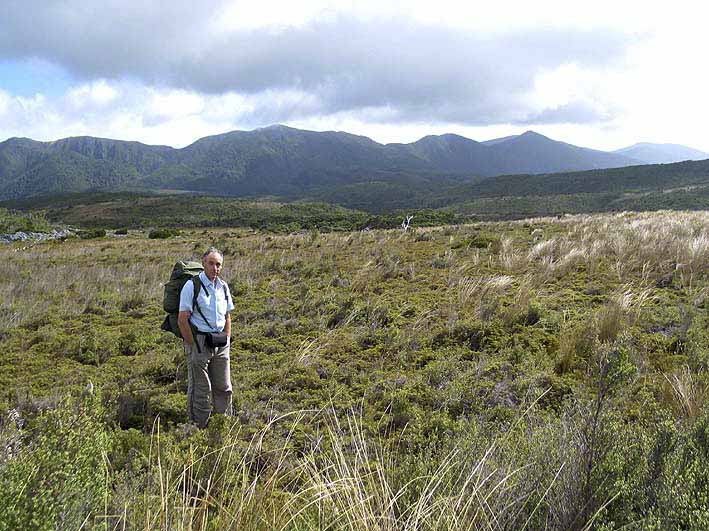
The beginning of the Gouland Downs.
Why the brown water?
The water in the streams seemed to be getting browner
than ever. This made me doubt the official explanation that it is tannin
from Beech tree leaves and roots that causes it. How could trees supply so
much colour, year in and year out? Raymond and I argued good naturedly about
this. He like most educated persons supported the 'official explanation' but
I tried to shoot holes in it.
Raymond and I have different points of view on many
things. I pointed out that the trees were no longer Beech and were getting
sparser by the minute, but the water was browner than ever. He didn't seem
convinced.
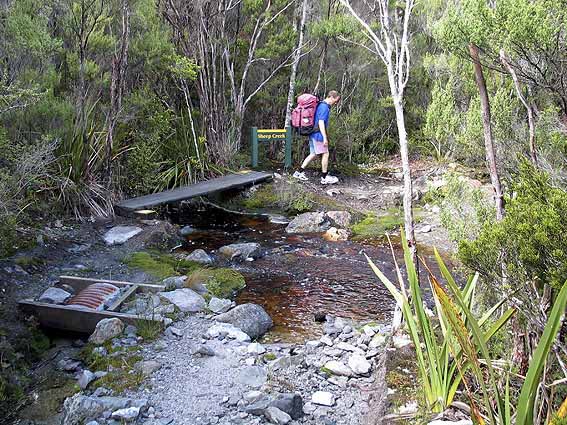
Extremely brown water.
The famous boot pole
We eventually came to the famous boot pole where worn
out or broken boots (not surprising considering the rough terrain) had been
abandoned. The original pole was much bigger a ranger told me later that
morning, but had collapsed under the weight of the boots.
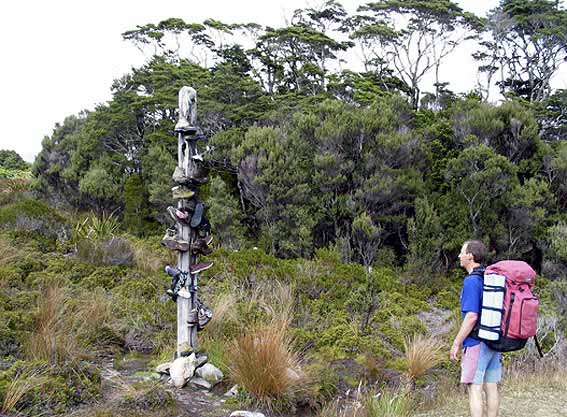
The boot pole.
Rare blue ducks
After that we walked along a high ridge and could hear a
largish river down in the tree lined gully. We caught glimpses of it through
the trees, deep, clear, and very brown. Quite spectacular where the white
foam of rapids contrasted with the brown deeper water.
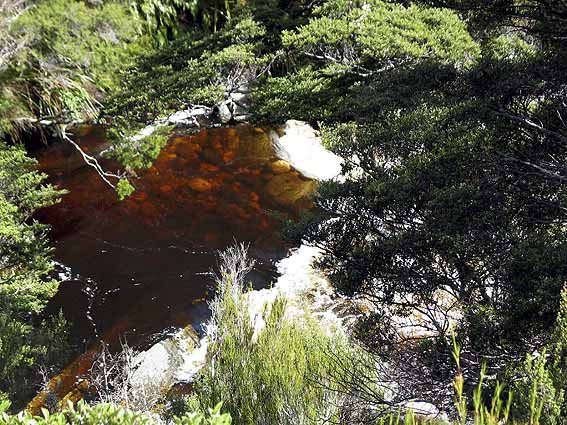
Looking down on the large river in the
gully.
As we neared the bridge over this river, we heard a
strange noise like a cross between the croak of a bullfrog and the honk of a
goose. As we crossed the bridge Raymond spotted two grey coloured ducks on a
rock down in the river. A ranger later told us that these were the extremely
rare Blue Duck. Raymond managed to get a close up photo using the maximum
zoom on his camera.
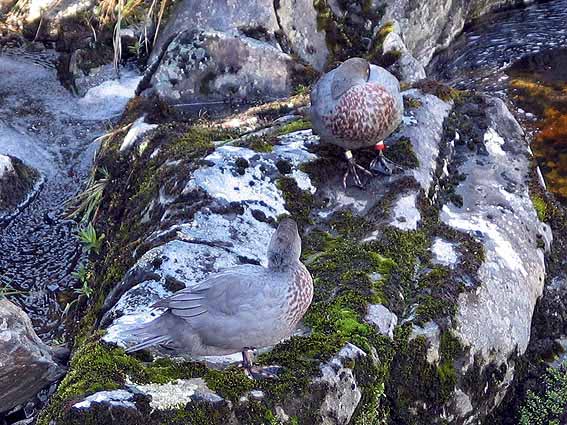
Rare blue ducks.
Stoat traps
Along this part of the walk we saw several traps by the
sides of the track. They had 'Do not touch' written on them, but I couldn't
resist taking the lid off one and looking inside. It appeared to be a stoat
trap, baited with a hen egg. The ranger later confirmed this, but he said
that they hadn't caught anything for six months.
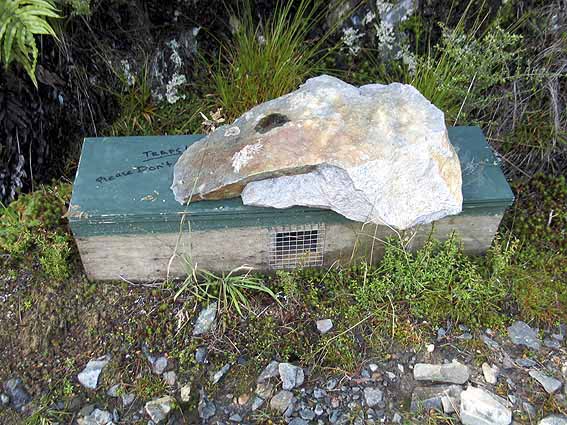
Stoat trap, baited with a
hen's egg inside.
We
arrive at the small Gouland Downs hut
About mid-morning we arrived at the small Gouland
Downs hut which we had seen in the distance for nearly an hour. There was a
raised wooden platform here for camping on. It was warm and dry from the
sun. Felt luxurious. I took off my boots and socks and laid them out in the
sun to dry and sat on the platform and enjoyed a snack of peanuts and
raisins.
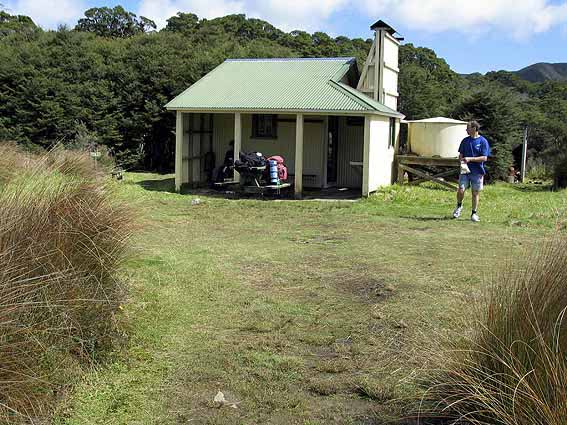
The small Gouland Downs
hut
Graham
the friendly, white bearded ranger
A friendly, white bearded ranger, Graham, who had
also visited us in our hut last night, came by and we had a chat together
sitting on the wooden platform in the sun. He remarked that we both had the
same boots (Hi-Tech).
I told him about the overgrown access to the bridge. He
counselled me that I should not have wet both pairs of my socks. "You should
always have a dry set of clothes to sleep in, and then put your wet clothes
back on again while you are moving and keeping warm."
I asked his opinion on lace-up rubber boots, which to me
seemed more practical for our wet bush conditions, as they are waterproof,
light and dry quickly. He said he has a mate who swears by them. He also
said that he used to wear lace-up rubber boots himself, but slipped on a
rock in a river once and injured himself, and hadn't worn them since.
Meaning I suppose that the rubber soles were not as grippy as those of good
boots. I suspected that rubber boots could be bought with quality soles and
made a mental note to look into it when I got home. Leather boots get heavy
when they get wet inside and take days to dry out. They also get hot in the
summer. The claim that leather 'breathes' is I believe just advertising
hogwash. Leather is permeable, but not to the extent of allowing air
circulation. They are hot, in summer, just like a leather jacket.
Feel really good, this life is simple.
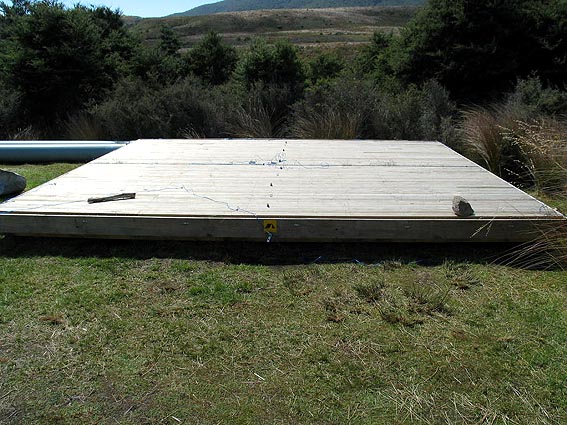
Tent platform at the Gouland Downs hut
Time to move on, so I my put socks back on
(still damp being wool) and my pack. The pack strap pressure is not
bothering us today. Raymond's blister is also holding up well. In fact I
feel really good. We are completely remote from the stresses of modern life.
No phones, no traffic, no meetings, no computer, no work, no bills. All we
have to do is walk the track. Life is simple.
Limestone
caves and glow worms
We now entered limestone country with several
small caves. We did a bit of exploring and found one that had glow worms in
it. I took a photo of them up close, but they look a lot more glamorous from
a distance in the dark.
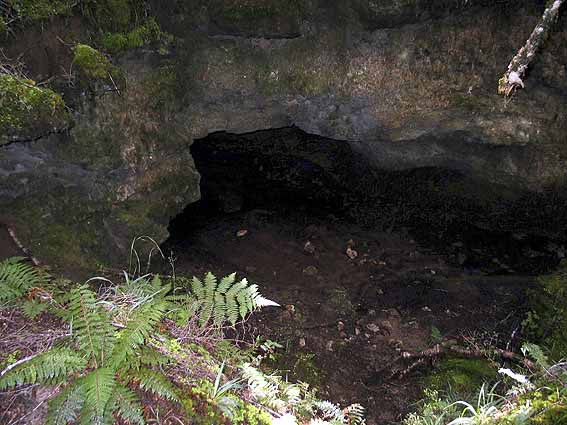
Limestone cave.
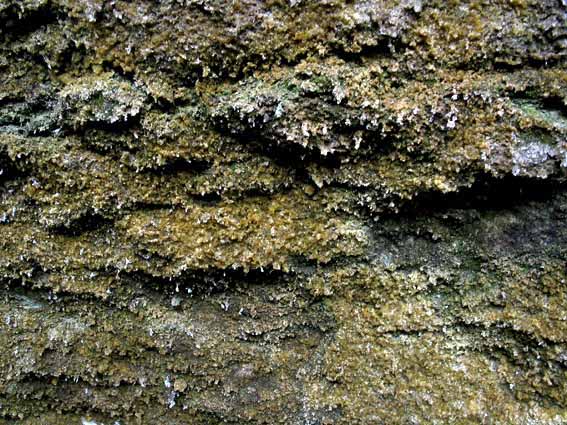
Glow worms up close "better in the dark."
Swampy
areas, muddy tracks, boardwalks
and swing bridges
Next we descended into a low lying, swampy area. Mostly
tussock and scrub, with many boardwalks, muddy tracks, and swing bridges
over the swampy rivers.
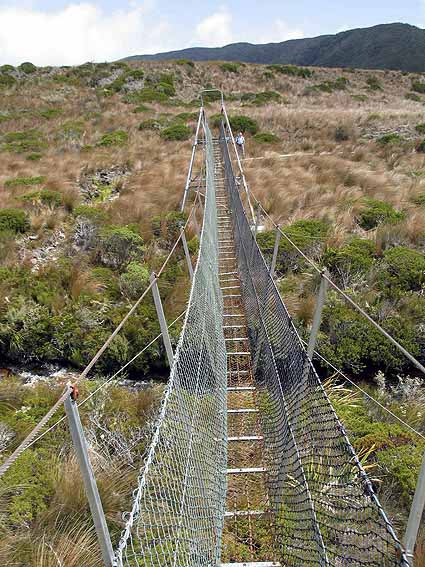
Typical swing bridge over
the swampy areas of the track.
I couldn't help pointing out to Raymond that the
water was as brown as ever, and not a tree for miles. I decided that the
brownness must come from the fractured brown rock that is predominant
throughout the Kahurangi Ranges. We walked a huge distance, some of it
climbing.
After the first swing bridge the track changed from a
four wheel drive bike track, to a single dirt track with sand in many
places. Much smoother to walk on. It remained a single track for the rest of
the walk.
Lunch
at the modern Saxon Hut
Soon came the welcome sight of the Saxon Hut.
This is a modern hut, and an optional stay for those who are doing the track
in five days instead of two.
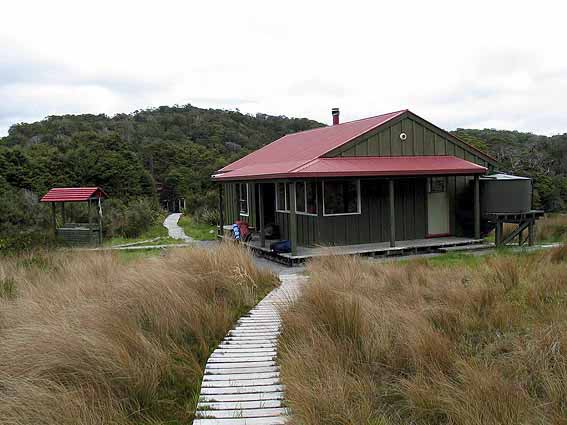
The Saxon Hut
Here we again met the 69 year old Colorado
professor Jerry. He was taking the track easy and planned to stay there the
night. I left my boots and socks to dry some more in the wind while we
rested there for about an hour and had lunch. Again I could only eat half my
lunch. I thought I would be starving with all the calories I was burning.
Perhaps it's the stimulation.
Reynold
and Angelique
Reynold and Angelique, the couple from Holland
whom we had passed earlier arrived and we had a nice chat with them. Poor
Angelique, she was having trouble with one of her knees. It was quite
swollen. She also had blisters, but she still smiled continually. She is a
very nice person and I felt very sorry for her as there was still another 14
kms to go to the McKay Hut where we would be staying tonight.
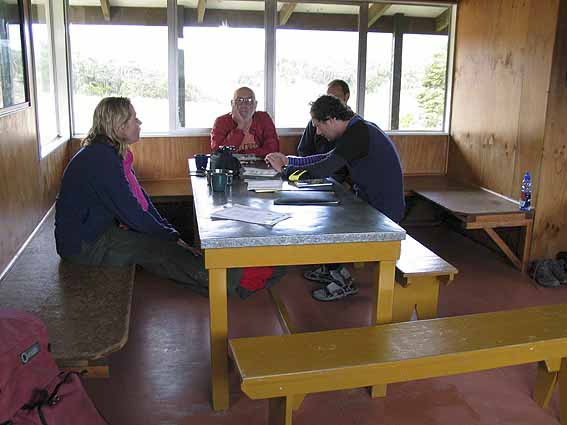
Trampers in the Saxon Hut.
L to R: Angelique, Jerry, Reynold and Raymond.
Reynold is also a very nice person. They have a little
girl (looked after in NZ by a grandmother while they walk the track) whom
Reynold said he loved so much he was reluctant to have any more children in
case he loved her less. I assured him that wouldn't happen, and that our
capacity to love increases as our family grows.
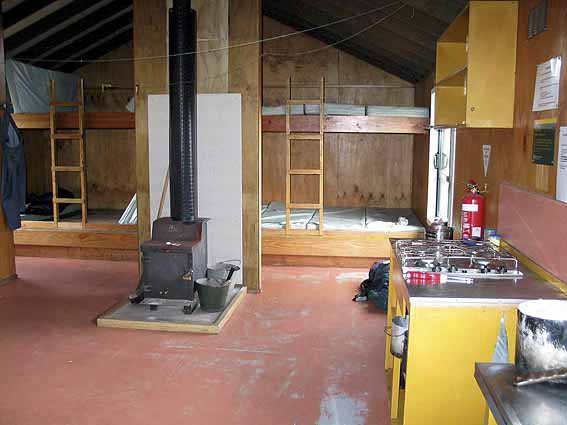
Main interior of the Saxon hut.
Trees
again and rocks
We set off again. Our written
track guide said that the next boardwalk section can flood after heavy rain
and become impassable. Graham the ranger told us earlier that he has had to
wade along that section of boardwalk. Fortunately it was OK today.
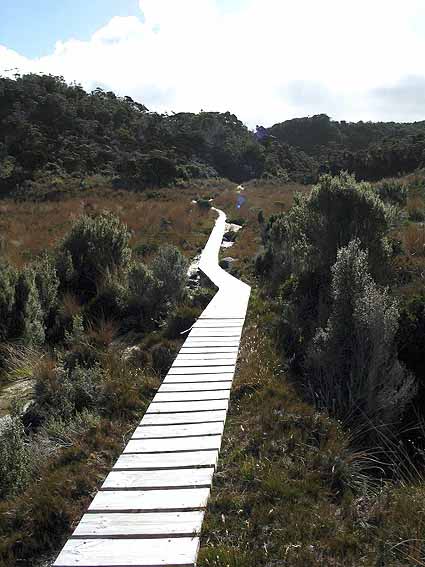
Boardwalk section
The tussock now began to give way to trees. A lot of
manuka with it's peely bark. These trees bring back pleasant memories from
my childhood days on the farm in the Hutt Valley. Manuka also makes
excellent firewood.
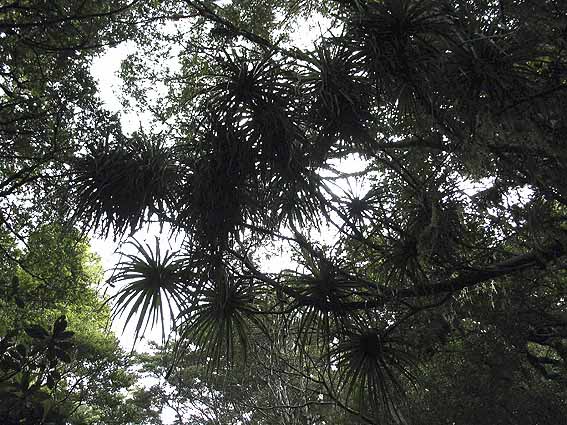
Spider trees.
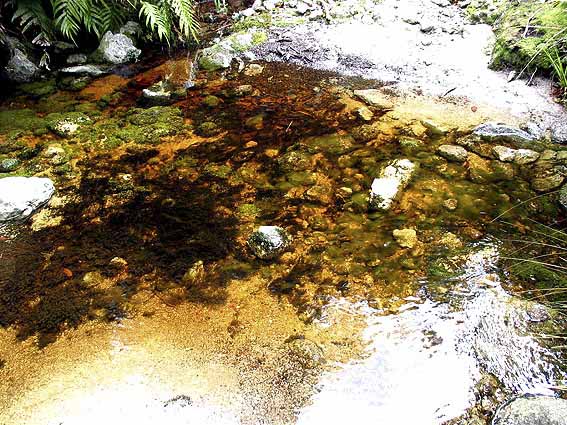
Coloured stream.
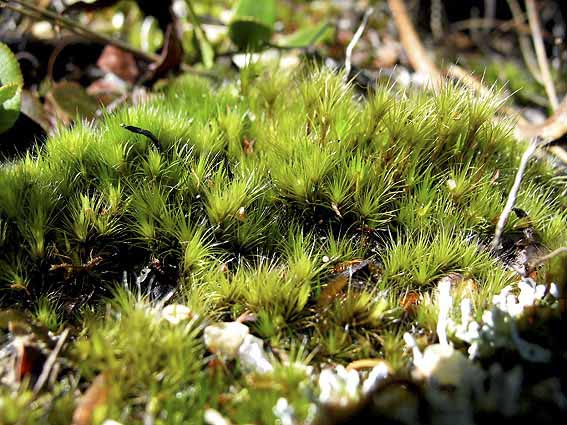
Spiky grass.
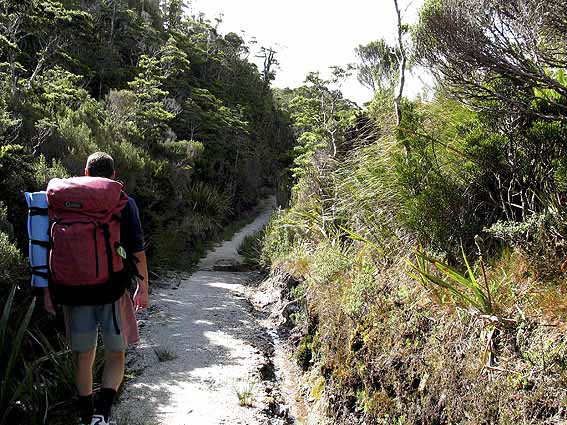
Typical track on this part of the walk.
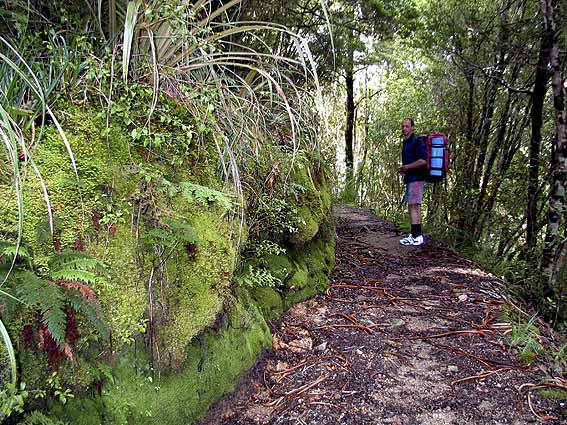
Mossy banks.
A lot of sandy sections on this part of the track. We
passed some interesting huge rocks. As I mentioned earlier today's section
was a long 27 kms.
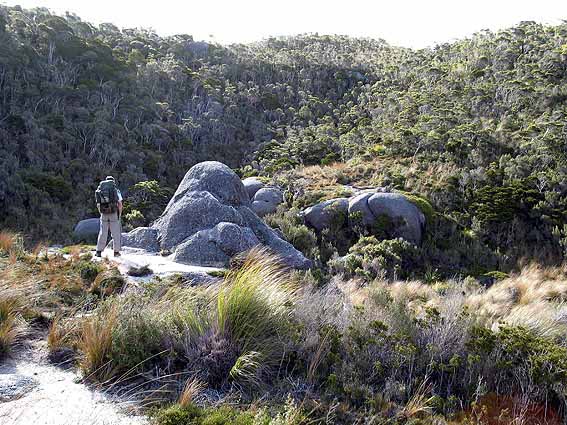
Rock formations.

Raymond hugging the rock.
Soles
of my feet begin to feel tender
After 25 kms the soles of my feet began to feel tender.
This may have been because of my damp socks, which soften the skin. So I put
on a light pair of sneakers, which we were told to carry to wear in the huts
at night to keep the floors clean from mud. What a difference in balance
wearing this footwear! Even with my pack weight I felt far more nimble and
sure footed crossing a small stream. However, in light footwear like this,
feet do squirm around more on uneven surfaces and can easily lead to
blisters. The rigidity of a boot is best long term. Graham the ranger told
me that he once found a Chinese man walking the track bare foot. He made it
to the first hut but had a bandage around one foot. There was also a young
Japanese man who carried a guitar, even though it was raining, and asked for
permission to walk the track naked. He told him he had to at least wear his
underwear, otherwise he would frighten the natives.
We
finally arrive at McKay Hut
Finally we arrived at McKay Hut. This hut is
sited high up on the mountain ridge and looks out to the West Coast, far
below in the distance.
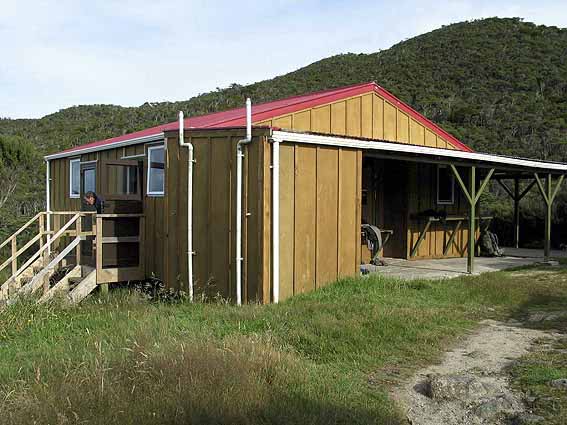
The McKay Hut.
You can even see the spectacular white foamy waves of
the tumultuous mouth of the Heaphy River, where it enters the ocean. That's
tomorrow's walk of 22 kms.

The West Coast mouth of the Heaphy River in the distance.
The
Belgium Snorer
This modern hut was half full of strangers. Some
had come from the other direction. There was a snowy white haired,
middle-aged man from Belgium and his wife. Very quiet couple. He had even
brought along a large bottle of wine. From tomorrow onward Raymond would
jokingly call him "the Belgium Snorer." He slept near Raymond and snored
extremely loudly for about an hour until his wife awoke and prodded him and
he turned on his side. It might have been the wine perhaps. That was the
only snoring we heard on the whole trip, despite sleeping about 12 a night
in the huts. It would appear that physical fitness greatly reduces the
snoring problem. My past experience of communal sleeping with mostly unfit
Church members indicates that about 50% of men have this problem, most of
them of portly build.
Chocolate
porridge for tea
Before going to bed we had our evening meal. I
was getting tired of my dry food so I used one of the pots supplied and made
a liquid chocolate porridge from my porridge-milk powder-chocolate chip mix.
Raymond shared it with me.
Night time in the
hut
I walked around the hut in my damp socks for a while, to
try and dry them more, but they quickly became caked in mud on the bottom
due to the dirty floor, so I had to wash them out. Back to square one.
Graham the ranger I spoke to this morning told us that this was the best hut
to hear and see kiwis. He advised us to drag our mattresses outside on the
verandahs and sleep there. We had planned to do this, but the cold wind made
us change our minds.
Nice camaraderie again in the hut before bed, but the
personality mix wasn't quite as stimulating as last night. A bit packed
also. In all the huts there always seemed to be somebody brewing tea or
coffee. You would constantly hear the dull roar of the gas cookers or the
clicking of the spark generators along with conversation. The Belgium Snorer
also had a gas lamp that provided more light than the blue LED torches that
were common (Raymond and I had three between us).
Angelique's
swollen knee and blisters
Angelique smilingly showed us her swollen knee and large
blisters. If it had been Marie I think I would have asked the ranger to
order in a helicopter. We didn't see this couple again after this night's
stay. They may have remained an extra night in this hut.
Next day Friday 13th Feb
(To be added early 2010)